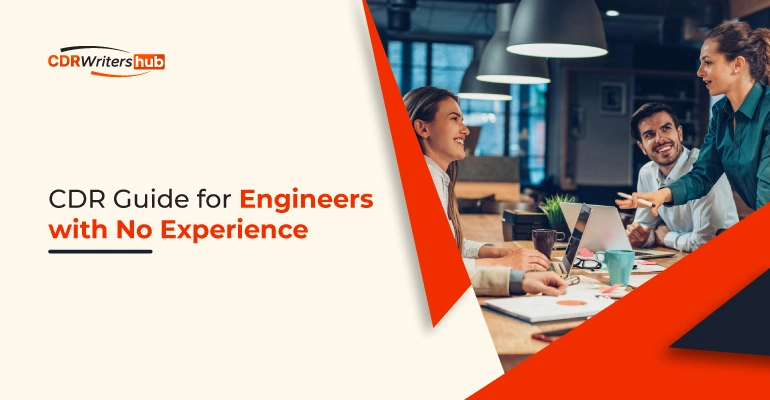How can engineers with no experience navigate the CDR process?

How can engineers with no experience navigate the CDR process?
If you lack work experience but aim to be an engineer in Australia, create an exceptional Competency Demonstration Report (CDR) highlighting education and project participation. Focus on skills and expertise rather than job history. This comprehensive CDR guide for engineers ensures success in showcasing your engineering qualities without traditional work experience.
Complete CDR Guide for Engineers with No Experience
Table of Contents
If you lack work experience but aim to be an engineer in Australia, create an exceptional Competency Demonstration Report (CDR) highlighting education and project participation. Focus on skills and expertise rather than job history. This comprehensive CDR guide for engineers ensures success in showcasing your engineering qualities without traditional work experience.
Let’s delve into the fundamental elements of a CDR Report for engineers and understand the significance of these reports and how to effectively prepare them.
- Curriculum Vitae (CV): Showcase educational and personal information to provide a comprehensive overview of your background.
- Continuing Professional Development (CPD): Demonstrate your dedication to continuous learning and professional growth.
- Career Episodes: Detail your participation in projects and highlight your engineering experiences.
- Summary Statement: Establish connections between your experiences and the competencies outlined by Engineers Australia.
We will offer a concise summary of each section to aid your understanding of the underlying concept. Let’s begin!
Curriculum Vitae
Crafting a Curriculum Vitae (CV) for your Competency Demonstration Report (CDR) is a crucial step for a favorable outcome. A meticulously written resume, encompassing your educational background, professional experience, qualifications, objectives, and achievements, plays a pivotal role in impressing Engineers Australia (EA).
Our adept team will assist you in creating a compelling resume, ensuring it incorporates all necessary elements. It’s important to maintain conciseness, and the overall content of your resume should not surpass three pages.
Continuing Professional Development (CPD)
Engaging in Continuing Professional Development (CPD) is instrumental in enhancing experience, maintaining up-to-date technical competencies, and advancing your engineering career.
CPD programs are specifically crafted to extend or refresh your expertise, knowledge, and perspectives within your field of study. This ensures that you not only retain professional competence but also contribute to the growth of your skill set. Your CPD record should reflect a minimum of 150 hours of structured learning activities in the relevant engineering field over a three-year period. This commitment enables you to bolster job performance and stay abreast of developments in your profession.
Career episode
The Career Episode Report required by Engineers Australia provides in-depth insights into an engineer’s technical and other skills relevant to their projects. In your career episodes, it is essential to showcase your professional capabilities, focusing on the tasks you have undertaken.
The primary objective of each career episode is to illustrate your technical expertise and competence in your chosen field. These episodes should adhere to a word count ranging from 1000 to 2500 words and must be written in Australian English.
For each episode:
- Opening: Commence with an opening.
- Project Details: Provide details on the project title, duration, location, and your designated role.
- Context: Elaborate on the background, outlining the project’s context and objectives.
- Individual Engineering Involvement: Detail your personal contributions, responsibilities, and tasks in the project. Highlight your problem-solving abilities, decision-making process, and technical competencies.
- Recapitulation: Conclude the episode by summarizing the achieved outcomes and underscoring your specific contributions.
Given your limited employment experience, consider emphasizing your academic projects, internships, research endeavors, or even personal projects that are relevant to your field. Highlight how these experiences allowed you to apply engineering principles and techniques.
Engineering Education
Detail your educational background, including:
- Degrees completed, such as a Bachelor’s or Master’s in Engineering.
- Name of institutions
- Dates of study
- Major subjects studied
- Academic achievements or honors
Summary Statement
Once you have completed the composition of your three career episodes, the subsequent task involves crafting a summary statement. Summary statements serve as comprehensive summaries of all competency aspects gleaned from your professional experience.
To ensure thorough coverage, a meticulous examination of your career episodes is imperative, connecting the dots seamlessly. It is crucial to articulate the content accurately, interlinking the key elements across your career episodes. While only one summary statement is mandated for all three career episodes, it is advisable to exceed the limitation of a single page for this crucial component.
How do you write a CDR report if you don’t have any work experience?
By effectively combining the aforementioned elements in your CDR report, you become eligible for submission to Engineers Australia. Yet, for individuals facing a challenge due to a lack of employment experience, there is a potential solution. A key area to concentrate on is the career episode, where all completed projects are detailed.
In situations where traditional employment experience is absent, candidates can highlight projects undertaken during academic studies, training periods, or workshop-based projects.
The following section must be written properly:
Introduction
The initial segment marks the commencement of the career episode, encapsulating pertinent details within a concise 100-word limit. This section necessitates the inclusion of the following key components:
- Commencement and conclusion dates
- Organization’s name
- Location
- Job title/position
- Supervising authority
Background
This segment provides a concise overview of the project, delineating the work area’s characteristics and detailing your responsibilities within the project. The background portion establishes the context of the described project, elucidating its nature and objectives. All background details should fall within the word range of 200 to 500 words.
Personal Engineering Activity
The central element of the Career Episode is the individual Engineering Activity, which is expected to be within the range of 500 to 1000 words. This segment encompasses comprehensive explanations of the tasks undertaken in a project, offering specific insights into the practical application of your engineering skills. It delves into the particulars of your achievements, outlines the approach taken to address technical challenges or obstacles encountered during the project, and emphasizes the problem-solving methods employed.
Summary
Summarize the project tasks accomplished and highlight engineering abilities within a word count of 100 to 120, adhering to the format outlined in the Migration Skills Assessment (MSA) guide for CDR writing. Start by selecting the specific engineering job for evaluation and familiarize yourself with the required skills. Follow the steps outlined in the CDR writing process, including personal information, application details, education, employment, and the project report.
Personal Information
- Cover page containing your passport details
- Curriculum Vitae
- Photograph of passport size
- Documents verifying any changes in name
- Score report of English language proficiency test (IELTS / PTE ACADEMIC™)
Application Information
- Evidence of registration
- The engineering occupation chosen by the applicant
Choose your engineering profession based on the ANZSCO code list accurately.
Education details
- Academic or educational transcripts
- Degree certificates obtained during your educational years
- Transcript and enrollment letter
- Supplementary documents for additional qualifications
Employment
- Proof of work experience
- Documents in languages other than English, both translated and in their original language
If asserting over a year of engineering work, a reference letter (containing pertinent details) from your company must be provided.
The Competency Demonstration Report (CDR) is a compulsory document engineers need to submit for acquiring a skilled migration visa to work in Australia. Engineers Australia evaluates these reports to assess the competency of the engineers. The Migration Skills Assessment (MSA) has established precise guidelines for the construction of CDR reports.
Failure to meet these requirements will result in a delay in your CDR application, preventing you from going to Australia until the suspension period concludes. The primary reason for the rejection of your CDR report is typically its non-compliance with the specified MSA requirements.
Read more : Consider professional assistance for CDR writing from experts.👍😊
Conclusion
In summary, for a successful Competency Demonstration Report (CDR) in Australia, emphasize education, projects, and skills. Use a concise Curriculum Vitae, active Continuing Professional Development (CPD), detailed Career Episodes, and a strong Summary Statement. Highlight academic projects for those without work experience. Adhere to guidelines and comply with Migration Skills Assessment (MSA) for a smooth submission process.
FAQ
How can I create an exceptional CDR without work experience?
Emphasize academic projects, internships, or research relevant to your field in your Career Episodes. Showcase your engineering skills and achievements.
Learn more: Take a help form Expert CDR Writers ⭐⭐⭐⭐⭐
What elements are essential in a Curriculum Vitae (CV) for the CDR?
Include educational background, professional experience, qualifications, objectives, and achievements. Keep it concise, within three pages.
What is Continuing Professional Development (CPD) in the context of a CDR?
CPD demonstrates your commitment to continuous learning and professional growth. It involves engaging in structured learning activities related to your engineering field for a minimum of 150 hours over three years.
How should I structure my Career Episodes without work experience?
Focus on academic projects, training periods, or relevant workshop-based projects. Follow the structure: Introduction, Background (200-500 words), Personal Engineering Activity (500-1000 words), and Summary (100-120 words).
What is the significance of the Summary Statement in a CDR?
The Summary Statement connects your experiences to the competencies outlined by Engineers Australia. It provides a comprehensive overview of all competency aspects gleaned from your professional experience.
What documents are required for the application information section of the CDR?
Include evidence of registration, the chosen engineering occupation, and relevant ANZSCO code.
What are the language proficiency requirements for CDR submission?
Submit score reports of English language proficiency tests like IELTS or PTE ACADEMIC.
Can I include projects undertaken during academic studies in my Career Episodes?
Yes, especially if you lack traditional work experience. Highlight how these projects allowed you to apply engineering principles and techniques.
What happens if my CDR report doesn’t meet the Migration Skills Assessment (MSA) requirements?
Failure to meet MSA requirements may result in the rejection of your CDR application. Ensure compliance to avoid delays and suspension.
How can professional assistance benefit CDR writing?
Professional assistance ensures adherence to guidelines, compliance with MSA requirements, and increases the chances of a successful CDR submission for skilled migration to Australia.




